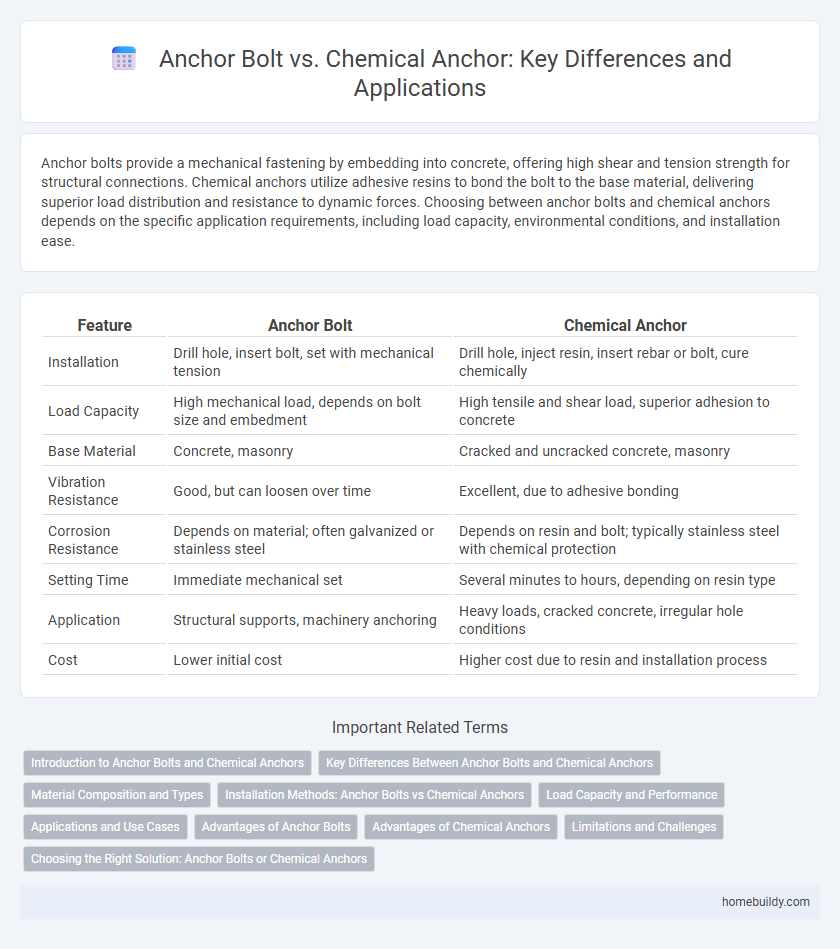Anchor bolts provide a mechanical fastening by embedding into concrete, offering high shear and tension strength for structural connections. Chemical anchors utilize adhesive resins to bond the bolt to the base material, delivering superior load distribution and resistance to dynamic forces. Choosing between anchor bolts and chemical anchors depends on the specific application requirements, including load capacity, environmental conditions, and installation ease.
Table of Comparison
| Feature | Anchor Bolt | Chemical Anchor |
|---|---|---|
| Installation | Drill hole, insert bolt, set with mechanical tension | Drill hole, inject resin, insert rebar or bolt, cure chemically |
| Load Capacity | High mechanical load, depends on bolt size and embedment | High tensile and shear load, superior adhesion to concrete |
| Base Material | Concrete, masonry | Cracked and uncracked concrete, masonry |
| Vibration Resistance | Good, but can loosen over time | Excellent, due to adhesive bonding |
| Corrosion Resistance | Depends on material; often galvanized or stainless steel | Depends on resin and bolt; typically stainless steel with chemical protection |
| Setting Time | Immediate mechanical set | Several minutes to hours, depending on resin type |
| Application | Structural supports, machinery anchoring | Heavy loads, cracked concrete, irregular hole conditions |
| Cost | Lower initial cost | Higher cost due to resin and installation process |
Introduction to Anchor Bolts and Chemical Anchors
Anchor bolts are mechanical fasteners used to secure structural elements to concrete or masonry surfaces by embedding steel rods into pre-drilled holes. Chemical anchors utilize adhesive resins to bond threaded rods or rebar within drilled holes, providing enhanced load-bearing capacity and resistance to dynamic forces. Both methods are critical in construction applications, with anchor bolts offering straightforward installation and chemical anchors delivering superior grip in cracked or weak substrates.
Key Differences Between Anchor Bolts and Chemical Anchors
Anchor bolts are mechanical fasteners embedded into concrete or masonry, providing high load-bearing capacity through physical expansion or threaded connections. Chemical anchors rely on adhesive resins, such as epoxy or polyester, that cure to bond bolts into drilled holes, offering superior performance in cracked or weak substrates. Key differences include installation methods, load distribution, and suitability for specific substrates, with anchor bolts favored for straightforward applications and chemical anchors preferred for enhanced holding power in challenging conditions.
Material Composition and Types
Anchor bolts are typically composed of carbon steel or stainless steel, offering high tensile strength and corrosion resistance for securing structural elements to concrete. Chemical anchors, by contrast, rely on epoxy, polyester, or vinylester resins combined with threaded rods made of stainless steel, galvanized steel, or carbon steel, providing superior load distribution and resistance in cracked or weakened substrates. The main types of anchor bolts include expansion bolts, wedge anchors, and cast-in-place anchors, while chemical anchors encompass capsule systems and injection cartridges tailored for varying installation requirements.
Installation Methods: Anchor Bolts vs Chemical Anchors
Anchor bolts are typically installed by drilling a hole and mechanically securing the bolt with expansion or undercut anchors, providing immediate load-bearing capacity. Chemical anchors require injecting a resin or epoxy into the drilled hole before inserting the threaded rod or rebar, allowing for a strong bond as the adhesive cures. Installation of chemical anchors demands more curing time but offers higher tensile and shear strength compared to traditional mechanical anchor bolts.
Load Capacity and Performance
Anchor bolts typically provide higher load capacity and superior mechanical strength compared to chemical anchors, making them ideal for heavy-duty structural connections. Chemical anchors rely on adhesive bonding to transfer loads, offering excellent performance in cracked concrete and flexibility in installation but generally lower load ratings. Both systems are selected based on specific project requirements, with anchor bolts favored for maximum load-bearing capacity and chemical anchors chosen for complex or retrofit applications.
Applications and Use Cases
Anchor bolts provide reliable fastening in concrete and masonry for structural supports, machinery, and heavy equipment. Chemical anchors excel in applications requiring high-load capacity and vibration resistance, such as seismic retrofitting and industrial installations in cracked or hollow concrete. Both systems are essential for construction and engineering projects, with selection driven by load demands, environmental conditions, and substrate type.
Advantages of Anchor Bolts
Anchor bolts offer superior mechanical strength and reliability for heavy-duty structural applications, ensuring robust load transfer and long-term stability. Their installation process is typically faster and more cost-effective compared to chemical anchors, reducing labor time and expenses. Additionally, anchor bolts provide easy inspection and maintenance without the need for chemical curing, enhancing overall project efficiency.
Advantages of Chemical Anchors
Chemical anchors provide superior load-bearing capacity and enhanced performance in cracked and uneven concrete compared to traditional anchor bolts. Their ability to distribute stress evenly reduces the risk of concrete damage, while offering excellent corrosion resistance and flexibility for different installation conditions. These advantages make chemical anchors ideal for critical structural applications where durability and reliability are paramount.
Limitations and Challenges
Anchor bolts face limitations in applications involving cracked concrete or irregular substrates due to their reliance on mechanical expansion for load transfer, which can lead to reduced holding capacity and potential failure under dynamic loads. Chemical anchors, while offering superior performance in such demanding conditions through adhesive bonding, present challenges including longer curing times, sensitivity to installation temperature, and potential environmental hazards linked to resin components. Both types require careful consideration of substrate condition, load requirements, and installation environment to ensure optimal embedded depth and reliable structural support.
Choosing the Right Solution: Anchor Bolts or Chemical Anchors
Anchor bolts provide high load capacity and durability for heavy structural applications, fastening objects securely to concrete or masonry. Chemical anchors, utilizing epoxy or resin-based adhesives, offer superior performance in cracked concrete and irregular substrates, allowing for precise placement and reduced installation stress. Selecting between anchor bolts and chemical anchors depends on factors like load requirements, environmental conditions, and installation complexity to ensure optimal safety and structural integrity.
Anchor bolt vs Chemical anchor Infographic

 homebuildy.com
homebuildy.com